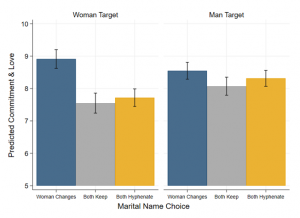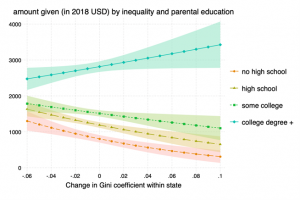A college degree is often a ticket to the middle class, but not everyone has the same chance to obtain one. Social scientists have long known that parents’ education matters a lot: the children of college-educated parents graduate from college at higher rates than the children of parents without a bachelor’s degree.
But this widely known fact hides another one: there’s a lot of variation in graduating from college among students whose parents have the same education level. Among students whose parents do not have a college degree, 29% go onto become first-generation college graduates. And among students with at least one parent who graduated from college, 34% do not graduate from college themselves.
What differentiates the students who become first-generation college graduates from those who don’t? And what differentiates students who become continuing-generation college students from those who don’t?
To answer these questions, we drew upon The National Longitudinal Study of Adolescent to Adult Health, a longitudinal dataset of American youth.
We find that first-generation college graduates are often the advantaged members of their disadvantaged class. Though their parents did not graduate from college, they are disproportionately from higher income families, have parents who work in jobs with more authority and autonomy, and have parents with higher expectations that they go to college. They also live in higher income neighborhoods, and are more likely to work with mentors. They are more often healthy. Contrary to how we often think of advantage, more are girls than boys.
Likewise, students who do not become continuing-generation college graduates are often the disadvantaged of the advantaged. Compared to other kids with college-educated parents, they are more likely to have parents with lower incomes and who work outside the most authoritative jobs, and they see their parents as being more accepting of not graduating from college. They also are more likely to live in lower income neighborhoods that have higher unemployment rates and to attend schools that are less funded. They more often have health issues and learning difficulties. But, departing from the pattern, more are boys than girls.
Interestingly, we also show that a lot of what parents do and don’t do that we all tend to think could matter for helping their children graduate from college, actually doesn’t. Among parents who did not graduate from college, it doesn’t matter if they talk to their children about school and work, work on school projects with them, or choose their neighborhood for its schools—their kids have the same chances of graduating from college either way. It also doesn’t matter if these parents put their kids in schools with low class sizes, more experienced teachers, or high school funding.
Among parents who have a bachelor’s degree, many things we tend to worry about also don’t matter for whether their children graduate from college. This includes putting their kids in schools with high achieving peers, small class sizes, and more experienced teachers, as well as helping their children find mentors.
There’s also another surprising fact: among students whose parents have the same resources, there are no white/black or white/Hispanic differences in becoming a first-generation or continuing-college graduate. Black students are less likely to graduate from college than white students, but this seems to be driven by their parents having fewer resources.
About a third of students who could become first-generation college graduates do so, and about a third of students who could become non-continuing-generation college graduates do so. Does this highlight the openness of the class structure? We don’t think so. As it’s the advantaged members of disadvantaged groups who graduate from college and the disadvantaged members of advantaged groups who don’t, our findings reinforce the idea that college is mostly closed to the disadvantaged and open to the advantaged. It’s mostly students whose parents have high levels of resources for their educational background who graduate from college—hardly a ringing endorsement of an open system or a meritocracy.
Anna Manzoni is Associate Professor of Sociology at North Carolina State University. Her current research interests include youth transition to adulthood, intergenerational support, inequalities in college access and returns and social mobility more broadly. Her work has been published in Advances in Life Course Research, European Sociological Review, Journal of Family Research, Journal of Youth and Adolescence, Journal of Higher Education, PLOS one, Research in Higher Education, Social Forces, Sociological Methodology, The Sociological Quarterly, among other journals. Follow her on Twitter @theitalianna
Jessi Streib is a sociologist at Duke University. She is the author of three books on class, including the forthcoming The Accidental Equalizer: How Luck Determines Pay After College. Follow her on Twitter @JessiStreib












